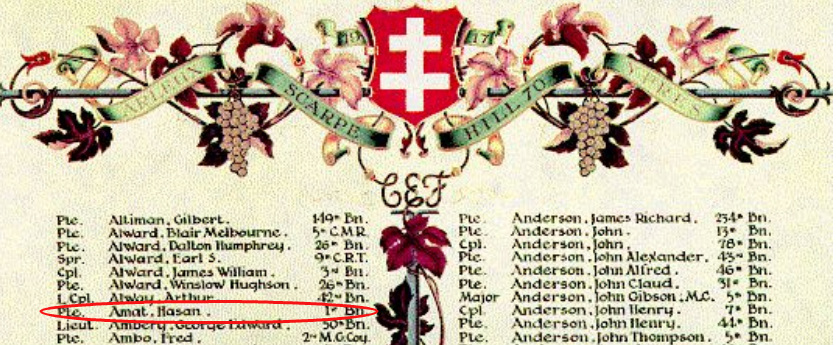
Canada’s first book of remembrance is also its largest. It details the names of more than 66,000 Canadians who died in World War One.
Page 191 of First World War Book of Remembrance holds the name of a Muslim man, Hassan Amat (sometimes written Hason or Hasan), the only Muslim soldier to have died fighting for Canada in WW1, according to Georgiana Stanciu, the executive director of The Royal Canadian Regiment Museum in London.
It is believed that 22 Muslims served in the Canadian armed forces in WW1.
War records are sometimes difficult to track down, and this is no different for Mr Amat. More so given the variations of his name.
An article by the Canadian Broadcasting Corporation (CBC) refers to Mr Amat as Hassan Amat, in an article published on August 20, 2017.
The article gives us rich details about his life, service, and premature death at just 23.
The Canadian National Vimy Memorial lists the names of the 11,285 Canadian soldiers listed as “missing, presumed dead” in France, including Mr Amat. Another 6,994 missing Canadians have their names carved into the Menin Gate at Ypres, Belgium.
The Commemorative Certificate lists his military service number. A search of this number allows us to find his military transcripts, digitised by the Library and Archives of Canada.
This archive confirms that he was born on January 1, 1894, in Singapore. Medical records confirm that he stood at 5 feet and 2 inches, weighing 118 lbs (8.4 stones).
He enlisted in the Canadian armed forces on January 14, 1916, according to the Canadian Great War Project. Subsequent forms offer some illuminating details, including his faith, written in pen as Mohamedan. A second enlistment form had written Mohammaden.
His initial rejection from the Royal Canadian Regiment (RCR) did not deter him. When asked about his previous military experience, Amat wrote: ‘Five minutes with the RCR at Halifax N.S.’.
Subsequent medical records confirm several hospital admissions for influenza during his short military career.
The Canadian War Museum (Musée canadien de la Guerre) noted how Amat had arrived in England with his unit in September 1916 before his re-assignment to the 1st Canadian Battalion in France in May 1917, in a Facebook post on May 9, 2017.
Amat and many others fought and died in the Battle of Hill 70. Around 100,000 Canadian soldiers took part in this battle, noted for the first-time command of Canadian forces by a Canadian commander named Sir Arthur Currie.
The Allies needed a distraction to prevent German forces from entering Belgium. Currie argued that his forces should attack higher ground, and the British agreed. The name Hill 70 alludes to its distance above sea level.
Canadian forces began their assault at the break of dawn on August 15, 1917.
The 10-day assault left 9,000 Canadians wounded or dead – including Amat who was killed by artillery fire on August 20.
Canadian forces held the hill, and Germany lost 25,000 soldiers.
Six Canadians received the Victoria Cross – the highest military honour in the Empire.
On August 20, 2017, dozens gathered Wolseley Barracks Cenotaph to remember those who served at the Battle of Hill 70.
Constable Emad Haider, from the Ontario Provincial Police, focused on the positive contributions of Canadian Muslims and said: “We don’t really see it often, especially in the media. We always hear what happened in terms of the negative stereotypes associated with Muslims.”
CBC London live-streamed part of the memorial event.
Nor was Canada’s armed forces always so welcoming to minorities.
The Chief of General Staff for the Canadian Armed forces once said in a memo: “Would Canadian Negroes make good fighting men? I do not think so.” This racist attitude trickled down to recruitment stations where in Sydney, Nova Scotia, fifty black volunteers were told plainly: “This is a white man’s war.”
First Nations volunteers sometimes lost their roles when their ethnicity became clear. Jewish Communities were proud to serve, having escaped the violent pogroms of Europe, despite the prevalence of antisemitic attitudes.
It was very difficult for Japanese and Chinese communities in Canada to volunteer.
Racist attitudes also prevented minorities from fighting. Black Canadians often had to settle for digging trenches or repairing roads.
The heavy loss of life forced a re-think in Canada’s military hierarchy in 1916. Recruitment towards minorities became more positive as the previous exuberance to volunteer among some minority communities was dwindling.
Nor did racist attitudes shift after the war despite the sacrifice of so many. It took a great deal of effort to enlist as a Japanese Canadian in a country which did not grant them the vote until 1931. Chinese Canadians faced similar racial discrimination. The Canadian government did not repeal its Chinese Exclusion Act until 1947.
Others now hope that the story of Hassan Atam will remind Canadians that Muslim Canadians have been part of their society since the Confederation of Canada in 1867.
